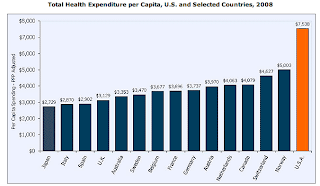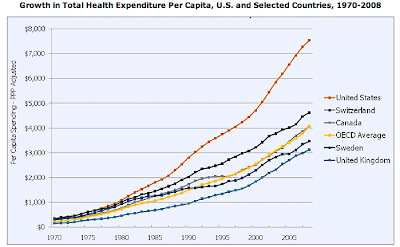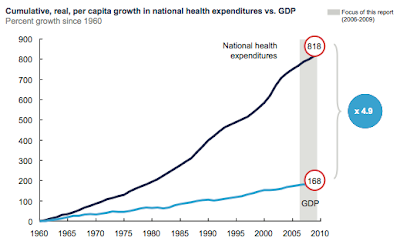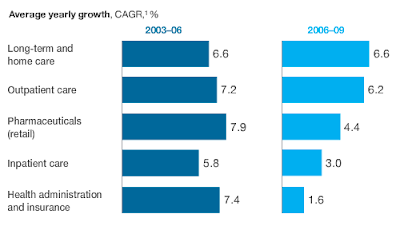A brief opinion by Gary Burtless of the Brookings Institute entitled "With Huge Health Care Costs, the U.S. Is a Huge Outlier" provides a few interesting facts about the level of health spending per person and the percentage of income that is devoted to the provision of health care in America. With the intense debate that surrounds the Affordable Care Act (ACA), the aging population and the growing level of public debt, this issue is not going to disappear any time soon, if at all. With both of those in mind, I thought that it was time to take a look at just how much America is spending on its health care system. Please note that in many cases, the most recent data is from 2009.
Over the past four decades, the share of GDP that America spends on health care has widened when compared to other countries. In the 1970s, the share of the American GDP that was devoted to health care was 40 percent higher than other wealthy countries. This gap continued to widen and, by 2010, U.S. health spending was 70 percent higher than other economies with similar incomes, reaching 17.4 percent of GDP in 2009, up from 9 percent in 1980.
Here is a graph showing the per capita spending on health care for a variety of advanced economies showing how much of an "outlier" the United States really is:
U.S. spending on health in 2008 was 51 percent higher than Norway, its closest competitor and nearly double the average of $3923 for the 15 countries on the graph.
Here is a graph showing the public and private health care expenditures for all OECD nations, once again showing that the United States is by far the largest spender:
The 2009 average spending on health care for all OECD nations was 9.6 percent of GDP with the United States spending 5 percentage points more than the next two countries; the Netherlands (12.0 percent) and France (11.8 percent).
While this extra spending would be justified if it led to improved health outcomes, it does not appear that American health outcomes are any better than its OECD peer group. On top of having high per capita spending, America's spending growth on health care is rising at a far faster rate than its peers as shown on this graph:
Here is a graph breaking down total spending on United States health care in 2009, showing how total spending of $2.486 trillion was $572 billion above expected spending when compared to healthcare expenditures in other developed economies:
These extra expenditures were based largely on comparably higher outpatient care costs, drug costs and health administration and insurance
When adjusted for inflation, cumulative real per capita spending on health care has grown by 4.9 times as much as GDP since 1960 as shown on this graph:
While the Great Recession did slow down the growth rate in spending on health care, certain categories saw very small reductions in spending growth, particularly long-term and home care and outpatient care as shown on this graph:
With the first baby boomers hitting their mid-60s this year, unless the upcoming senior cohort is willing to live in squalor, eat cat food and change their own Attends, annual spending growth of only 6.6 percent on long-term and home care is going to seem positively reasonable.
What is particularly concerning about all of this is that spending on American health care is showing no sign of slowing down at the same time as rising debt levels of government is showing no sign of slowing down. Washington relies very heavily on individual income taxes with nearly 85 percent of its revenue coming from the voting masses. With personal income growth stalling and people leaving the workforce in droves either out of frustration or because they are retiring, unless Washington feels like committing political suicide by raising personal taxation levels, revenue levels will not grow at the pace needed to fund health care costs that are rising at 7 percent annually ad infinitum.
Is it just me or does it look like America could well be entering the perfect health care storm? Two things are obvious, first, the current scenario is not sustainable and second, this issue alone will make it extremely difficult for Washington to cut its outlays.
Click HERE to read more of Glen Asher's columns
You can publish this article on your website as long as you provide a link back to this page.







Be the first to comment